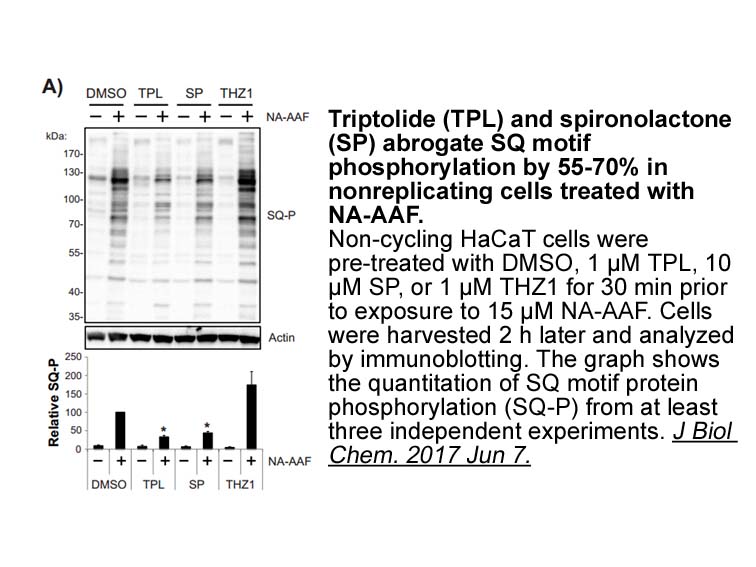Archives
The observed CORT induced increase in Cx phosphorylation at
The observed CORT-induced increase in Cx43 phosphorylation at S368 may also contribute to GJIC disruption. Gap junction channel permeability is modulated through connexin phosphorylation (Moreno and Lau, 2007). Specifically, the phosphorylation of Cx43 on S368 has been previously shown to decrease intercellular communication (Lampe et al., 2000). The mechanism by which CORT regulates Cx43 phosphorylation is not yet clear. Phosphorylation of Cx43 at S368 is a target of protein kinase C (Lampe et al., 2000). In addition, dexamethasone-mediated Cx43 phosphorylation was shown to be glucocorticoid receptor-dependent, indicating that glucocorticoid receptor participates in Cx43 phosphorylation (Samarasinghe et al., 2011).
Although important roles of gap junctions in depression have been revealed previously, only a few drug studies have focused on this therapeutic target. Our results indicate the potential of Rg1 to ameliorate CORT-induced damage to GJIC in prefrontal cortical and hippocampal astrocytes. This effect may be the result of Rg1-induced upregulation of Cx43 and the downregulation of phosphorylated Cx43. However, we cannot currently rule out other possible mechanism of action. Although no previous study has examined Rg1 effects on GJIC in astrocytes, ginsenoside Rb2 prevents the downregulation of GJIC in WB-F344 rat liver epithelial cell lines by countering oxidative stress (Kang et al., 2000). This may be relevant to Rg1's mechanism of action in glial cells, as Rg1 also has been shown to have strong antioxidant effects (Ma et al., 2013). Furthermore, RU486, an antagonist of the glucocorticoid receptor, efficiently blocks the activity of Rg1, suggesting that Rg1 may directly act on this receptor (Lee et al., 1997).
Introduction
Major depressive disorder (MDD) is a common mental illness that affects more than 350 million people worldwide, and exacts a very large economic burden (Smith, 2014). Although MDD has been studied for decades, current treatments are only effective in about half of patients. To understand the etiopathology of MDD, increasing attention has been given to astrocyte pathology, particular in the prefrontal Amikacin synthesis and hippocampus (Banasr and Duman, 2008, Czeh et al., 2006, Rajkowska and Stockmeier, 2013). Gap junctions mediate direct communication between adjacent astrocytes. Our previous data have shown that chronic unpredictable stre ss (CUS) caused the dysfunction of gap junctions in rat prefrontal cortex, dysfunction of gap junctions induced depressive-like behaviors in rats (Sun et al., 2012). However, the mechanism underlying CUS-induced dysfunction of gap junctions remains largely unexplored.
Gap junctions are mainly composed of connexin43 (Cx43) in cultured astrocytes (Giaume et al., 1991), though Cx26, Cx30, Cx40 and Cx45 are also found in astrocytes in the brain (Decrock et al., 2015). Cx43 and Cx30 are significantly downregulated in patients with depression and animals models of depression (Bernard et al., 2011, Ernst et al., 2011, Miguel-Hidalgo et al., 2014, Nagy et al., 2017, Sun et al., 2012). Infusion of Cx43 mimetic peptides Gap27 and Gap26 in the prefrontal cortex could induce anhedonia in rats (Sun et al., 2012). However, the mechanisms underlying these phenomena are poorly understood. Connexins have a short half-life of only 1–5 h (Berthoud et al., 2004). They are folded in the endoplasmic reticulum, and transferred to the cell surface via trans-Golgi network (Laird, 2006). N-Cadherin stabilizes membrane appositions of adjacent cells, thereby facilitating the formation of gap junctions (Frenzel and Johnson, 1996). Gap junction intercellular communication (GJIC) is modulated by phosphorylation of Cx43 (Pahujaa et al., 2007). The stability of Cx43 on membranes depends on the interactions of Cx43/ZO-1 and Cx43/drebrin complex, for instability of Cx43/ZO-1 and Cx43/drebrin have been found to promote Cx43 degradation (Suh et al., 2012). To be degraded, gap junctions can be internalized as annular junctions, or recognized by the membrane of the early endosome (Laird, 2006). Endocytic Cx43 in the cytoplasm can be degraded by autophagy and the proteasome system (Falk et al., 2014). These processes maintain the dynamic balance of Cx43 life cycle, modulating the function of gap junctions.
ss (CUS) caused the dysfunction of gap junctions in rat prefrontal cortex, dysfunction of gap junctions induced depressive-like behaviors in rats (Sun et al., 2012). However, the mechanism underlying CUS-induced dysfunction of gap junctions remains largely unexplored.
Gap junctions are mainly composed of connexin43 (Cx43) in cultured astrocytes (Giaume et al., 1991), though Cx26, Cx30, Cx40 and Cx45 are also found in astrocytes in the brain (Decrock et al., 2015). Cx43 and Cx30 are significantly downregulated in patients with depression and animals models of depression (Bernard et al., 2011, Ernst et al., 2011, Miguel-Hidalgo et al., 2014, Nagy et al., 2017, Sun et al., 2012). Infusion of Cx43 mimetic peptides Gap27 and Gap26 in the prefrontal cortex could induce anhedonia in rats (Sun et al., 2012). However, the mechanisms underlying these phenomena are poorly understood. Connexins have a short half-life of only 1–5 h (Berthoud et al., 2004). They are folded in the endoplasmic reticulum, and transferred to the cell surface via trans-Golgi network (Laird, 2006). N-Cadherin stabilizes membrane appositions of adjacent cells, thereby facilitating the formation of gap junctions (Frenzel and Johnson, 1996). Gap junction intercellular communication (GJIC) is modulated by phosphorylation of Cx43 (Pahujaa et al., 2007). The stability of Cx43 on membranes depends on the interactions of Cx43/ZO-1 and Cx43/drebrin complex, for instability of Cx43/ZO-1 and Cx43/drebrin have been found to promote Cx43 degradation (Suh et al., 2012). To be degraded, gap junctions can be internalized as annular junctions, or recognized by the membrane of the early endosome (Laird, 2006). Endocytic Cx43 in the cytoplasm can be degraded by autophagy and the proteasome system (Falk et al., 2014). These processes maintain the dynamic balance of Cx43 life cycle, modulating the function of gap junctions.